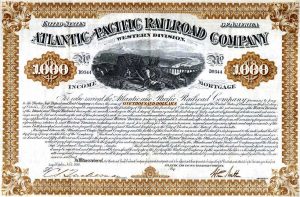
Few issues in the political life of Santa Barbara have generated as much controversy as the proposed Atlantic & Pacific Railroad in the early 1870s. Following the completion in 1866 of the Central Pacific-Union Pacific line, the nation’s first transcontinental railroad, a group of promoters announced their intention to build a second transcontinental line, to be called the Atlantic & Pacific Railroad, along the 35th parallel from St. Louis to San Francisco. From San Francisco a trunk line would extend south along the coast to Santa Barbara.
The benefits Santa Barbara would receive if it became the terminus of a transcontinental railroad were enormous. At that time, Santa Barbara could be reached only by ship or by a teeth-loosening stage coach ride along the coast. Connection to a transcontinental rail line would bring a surge of immigration, business and capital. In 1872, Colonel Hollister and Charles Fernald formed a railroad committee of prominent citizens to coordinate local efforts to facilitate the construction of the railroad.
Unfortunately, the Atlantic & Pacific promoters soon revealed a significant catch to the plan: they would build the coastal extension only if Santa Barbara paid the railroad a substantial subsidy, in advance, without any guarantee that the railroad would actually be built. Many business leaders initially favored the subsidy, despite its risks, because of the benefits of a railroad connection. Significant dissension also existed, however, which became public when Fernald was quoted as cautioning against “undue haste in jumping headlong into mortgaging the county unto unborn generations.”

The battle for the railroad quickly became heated. The arguments in favor of the subsidy scheme were advanced in the Santa Barbara Morning Press, founded in 1867 with financing from Colonel Hollister. Edited by Joseph A. Johnson, a brilliant but abrasive writer, the Morning Press hurled invective at anyone who opposed the payment of the subsidy. Johnson changed the name of the paper to The Santa Barbara Daily Press and then to simply The Press in 1872.
Previous Chapter
1869 to 1895Next Chapter
The Den Vs. Hollister Case

